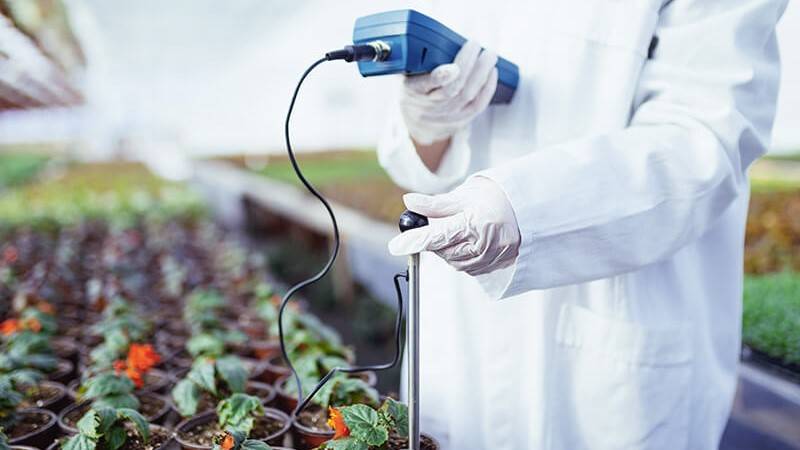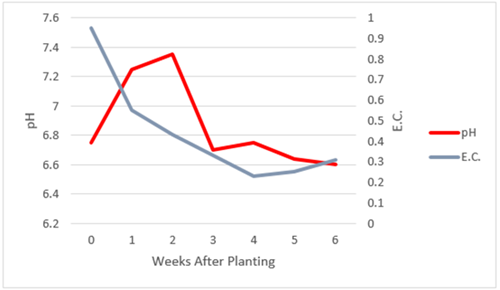Soluble Salt and pH levels in Fresh Organic Growing Media


A freshly made organic growing medium that contains starter organic fertilizers should be allowed to “rest” for 2-4 weeks after mixing before it is used. This is especially true if a grower makes his own growing medium as prepackaged growing medium has had enough time to rest by the time the customer uses it. The reason is that the growing medium has low population of microorganisms that break down organic fertilizer into useable forms.
Once the population of these microorganisms build up during the resting stage, the growing medium becomes “stable” and there is less fluctuation in its chemical properties.
In this article, we will discuss the rollercoaster ride of changing pH and soluble salt levels that justifies a “resting” period for organic growing media.
Why Are the First Weeks Crucial on pH Level Fluctuations
One of the main reasons that an organic mix should “rest” is that there are significant pH fluctuations that occur in the first few weeks after its production. Image 1 shows that as nitrogen mineralization takes place (in which organic proteins are broken down into ammonium), there are free hydroxides (OH-) released into the growing medium solution, which causes the growing medium pH to rise (Image 2). The pH rises by almost 0.5 unit or more in the first one to two weeks.

Mineralization Process

Nitrification Process
Once ammonium has built up in the growing medium along with the appropriate bacteria to break it down, the nitrification begins. As ammonium is converted to nitrite and then nitrate, hydrogen (H+) (or acid ions) start to build within the soil solution (Image 3).
This causes the pH of the growing medium to drop as seen in Image 2 from week 2 to 3. Beyond the first three weeks in Image 2, the pH is relatively stable because the microorganisms responsible for mineralization and nitrification have built up and both processes are occurring simultaneously.

The Impact of Fertilizer and Compost on Substrate pH Levels
How much the growing medium pH fluctuates has to do with the quantity of fertilizer/compost added to the growing medium as well as the storage temperature. The higher the amount of starter fertilizer or compost used, the higher the initial pH will climb during mineralization and then the greater the pH drop during nitrification. Warmer growing medium temperatures will speed up the mineralization and nitrification processes, shortening the time of the pH rollercoaster ride.
Keep in mind that as in conventional growing, nutrient availability for the plant is influenced by the growing medium pH. The micronutrients boron, copper, iron, manganese and zinc become unavailable as the pH of the growing medium exceeds 6.5. It is best to maintain a growing medium pH between 5.5-6.2 to minimize problems with micronutrient uptake (assuming they are provided by the fertilizer). If a growing medium contains compost, the pH is slightly less critical, but it is still best to maintain it within the same range.
Soluble Salts in Substrate
Through the processes of mineralization, in which organic matter proteins are converted to ammonium, nitrification, in which ammonium is converted into nitrate, and other processes, there is an initial release of a large quantity of mineral nutrients.
These mineral nutrients contribute to soluble salts or electrical conductivity (E.C.): the higher the mineral nutrients, the higher the E.C. High nutrient release is common in the beginning as mineral reserves in the starter fertilizer are high (Image 2).
This is also true if compost is used in a growing medium. As mineralization and nitrification continue, nutrient reserves decline and so does the E.C. It is possible that the E.C. could still be too high for healthy crop growth if too much starter fertilizer or nutrient-rich compost is added to the growing medium.
References:
- Fisher, P., J. Huang, M. Paz and R. Dickson. 2016. "Having Success with Organic Growing Mixes." Grower Talks. Feb 2016, 68-72.
- Pitchay, Dharmalingam and Gunawati Gunawan. 2017. "Detrimental Effects of Blood Meal and Feather Meal on Tomato (Solanum lycopersicon L.) Seed Germination." Hortscience 52(1): 138-141.